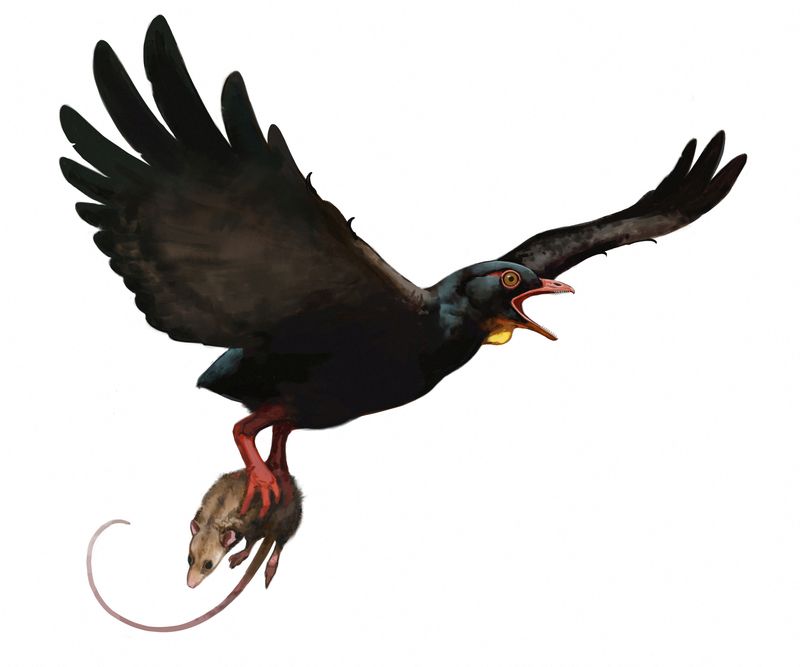By Will Dunham
WASHINGTON (Reuters) - In western North America during the twilight of the dinosaur age, the unquestioned ruler was Tyrannosaurus rex, one of the largest terrestrial predators in Earth's history. But there were many other predators earning a living in various ways, including - as new fossils show - the oldest-known birds of prey.
Researchers have discovered in Montana the remains of two newly identified Cretaceous Period avian species dating to about 67 million years ago that display anatomical traits resembling today's birds of prey. Specifically, they have a foot bone built in a manner that enabled them to capture, subdue and carry off prey just as hawks, owls and eagles do today.
The fossils were discovered in the same Hell Creek Formation rock expanse extending over four U.S. states where many dinosaurs, including T. rex, Triceratops, and Edmontosaurus, have been unearthed over the years.
The two are known solely from the tarsometatarsus, the foot bone between the ankle and the toes. Based on its dimensions, the larger of the two birds, called Avisaurus darwini, may have been the size of a big hawk, with a wingspan of perhaps 4-1/4 feet (1.3 meters). The other one, slightly smaller, is also of the genus Avisaurus, but its species name has not been coined.
The tarsometatarsus similarities to modern birds of prey "suggest they may have functioned similarly and maybe occupied an ecology not too unlike what we see today," said Alex Clark, a doctoral student in evolutionary biology at the University of Chicago and the Field Museum in Chicago and lead author of the study published on Wednesday in the journal PLOS ONE.
"In referring to a bird of prey, we specifically discuss extant birds that primarily use their feet and legs to either subdue or incapacitate prey," Clark added.
The two species may have hunted small mammals, lizards and other birds, as a hawk might today.
The first birds appeared roughly 150 million years ago during the Jurassic Period, evolving from small feathered dinosaurs. The two newly identified species belonged to the enantiornithines, one of the four main avian groups that lived during the age of dinosaurs. This group vanished in the mass extinction 66 million years ago caused by an asteroid strike that doomed the dinosaurs, aside from some of their avian descendants.
These newly identified birds of prey are not ancestral to any alive today, but rather evolved the same anatomical traits.
"The morphology that would equip an animal for raptorial-like behavior has likely evolved multiple times," Clark said.
Until now, the oldest-known birds of prey date to millions of years after the start of the Cenozoic Period, which followed the demise of the dinosaurs and witnessed the rise of the mammals.
The incomplete nature of the Avisaurus fossil finds leaves a mystery about what these birds looked like.
"Would these enantiornithines have had teeth or had hooked beaks, like many extant raptors? Both are possible, and only future discoveries will say," said Field Museum paleontologist and study co-author Jingmai O'Connor.
One trait seen on their tarsometatarsus was a robust muscle attachment point similar to that of hawks and owls.
"This is indicating powerful leg muscles and feet that could grip and potentially carry proportionally large prey," Clark said.
Another trait - grooves on the tarsometatarsus, called trochlea, indicating potentially powerful toes - is a feature present in modern birds of prey that is helpful in subduing prey to be carried off in flight.
The researchers also discovered remains of a third new bird species dating to the same time, called Magnusavis ekalakaensis, but its lifestyle remains unclear.

The discovery of these new species deepens the understanding of the ecosystems at the very end of the dinosaur era and fills in some gaps in the knowledge of bird evolution during this pivotal time for life on Earth.
"You have an ecosystem that can support a tyrant like Tyrannosaurus rex, but then you have enough small vertebrate diversity to support multiple species of likely birds of prey," Clark said.
